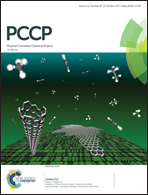Generic tags for Mn(ii) and Gd(iii) spin labels for distance measurements in proteins†
Abstract
High-affinity chelating tags for Gd(III) and Mn(II) ions that provide valuable high-resolution distance restraints for biomolecules were used as spin labels for double electron–electron resonance (DEER) measurements. The availability of a generic tag that can bind both metal ions and provide a narrow and predictable distance distribution for both ions is attractive owing to their different EPR-related characteristics. Herein we introduced two paramagnetic tags, 4PSPyMTA and 4PSPyNPDA, which are conjugated to cysteine residues through a stable thioether bond, forming a short and, depending on the metal ion coordination mode, a rigid tether with the protein. These tags exhibit high affinity for both Mn(II) and Gd(III) ions. The DEER performance of the 4PSPyMTA and 4PSPyNPDA tags, in complex with Gd(III) or Mn(II), was evaluated for three double cysteine mutants of ubiquitin, and the Gd(III)–Gd(III) and Mn(II)–Mn(II) distance distributions they generated were compared. All three Gd(III) complexes of the ubiquitin–PyMTA and ubiquitin–PyNPDA conjugates produced similar and expected distance distributions. In contrast, significant variations in the maxima and widths of the distance distributions were observed for the Mn(II) analogs. Furthermore, whereas PyNPDA–Gd(III) and PyNPDA–Mn(II) delivered similar distance distributions, appreciable differences were observed for two mutants with PyMTA, with the Mn(II) analog exhibiting a broader distance distribution and shorter distances. ELDOR (electron–electron double resonance)-detected NMR measurements revealed some distribution in the Mn(II) coordination environment for the protein conjugates of both tags but not for the free tags. The broader distance distributions generated by 4PSPyMTA–Mn(II), as compared with Gd(III), were attributed to the distributed location of the Mn(II) ion within the PyMTA chelate owing to its smaller size and lower coordination number that leave the pyridine nitrogen uncoordinated. Accordingly, in terms of distance resolution, 4PSPyNPDA can serve as an effective generic tag for Gd(III) and Mn(II), whereas 4PSPyMTA is efficient for Gd(III) only. This comparison between Gd(III) and Mn(II) suggests that PyMTA model compounds may not predict sufficiently well the performance of PyMTA–Mn(II) as a tag for high-resolution distance measurements in proteins because the protein environment can influence its coordination mode.



 Please wait while we load your content...
Please wait while we load your content...